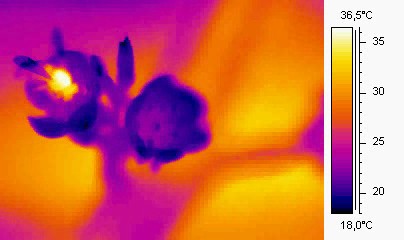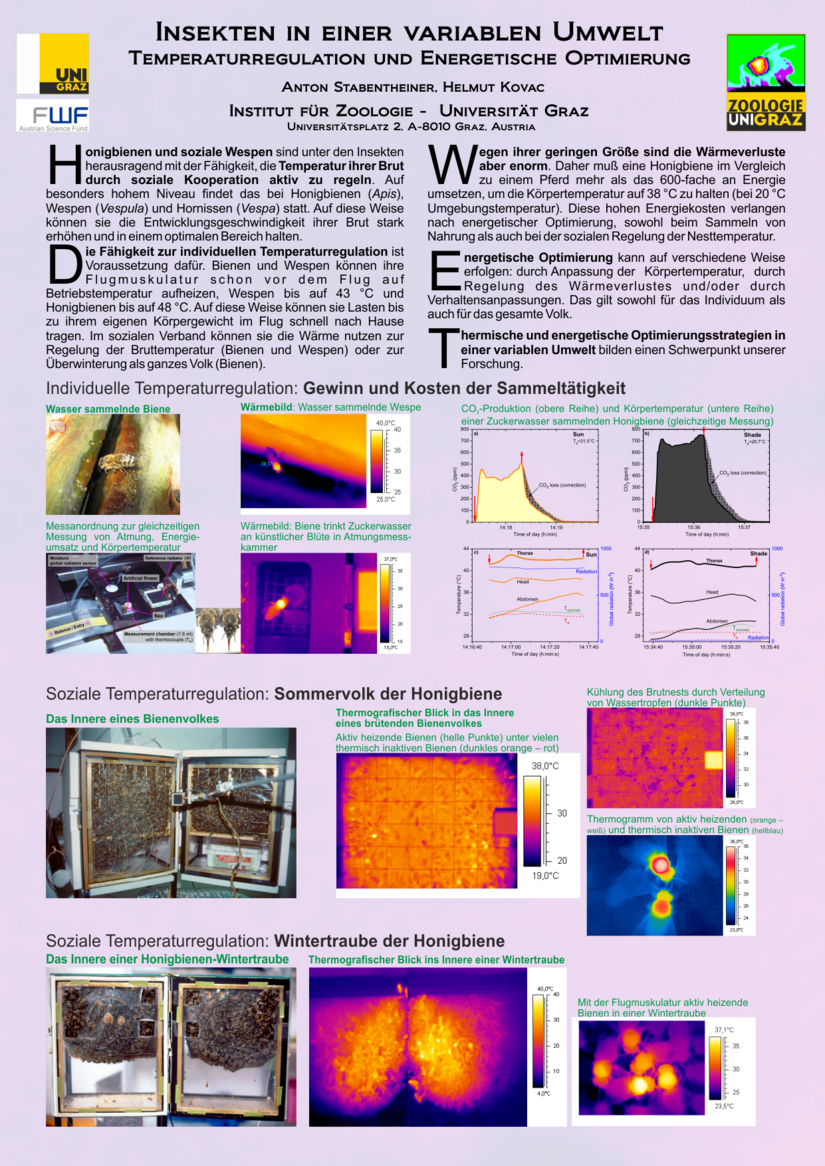Thermobiologie, Energetik, Ökophysiologie & Ökoethologie
Anton Stabentheiner
Institut für Biologie, Bereich Zoologie, Universität Graz - Universitätsplatz 2, 8010 Graz, Österreich
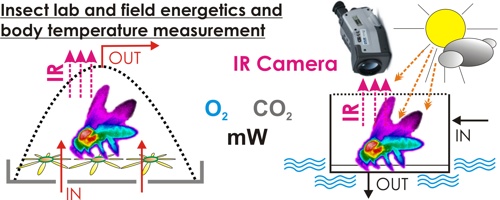
- Käfer H, Kovac H, Amstrup AB, Sørensen, JG, Stabentheiner A, 2025. Critical thermal maxima of Polistes life stages from different climates, with a critical evaluation of methods. Journal of Thermal Biology 129, 104111. DOI: 10.1016/j.jtherbio.2025.104111
- Amstrup AB, Kovac H, Käfer H, Stabentheiner A, Sørensen, JG, 2024. The heat shock response in Polistes spp. brood from differing climates following heat stress. Journal of Insect Physiology 156, 104111. DOI: 10.1016/j.jinsphys.2024.104667
- Stabentheiner A, Mauerhofer T, Willfurth R, Kovac H, Stabentheiner E, Käfer H, Petrocelli I 2024. The costs of overwintering in paper wasps (Polistes dominula and Polistes gallicus): the use of energy stores. Journal of Comparative Physiology B 194, 131-144. DOI: 10.1007/s00360-024-01540-w.
- Kovac H, Käfer H, Petrocelli I, Amstrup AB, Stabentheiner A 2023. The Impact of Climate on the Energetics of Overwintering Paper Wasp Gynes (Polistes dominula and Polistes gallicus). Insects 14, 849. DOI: 10.3390/insects14110849.
- Käfer H, Kovac H, Stabentheiner A 2023. Habitat Temperatures of the Red Firebug, Pyrrhocoris apterus: The Value of Small-Scale Climate Data Measurement. Insects 14, 843. DOI: 10.3390/insects14110843.
- Stabentheiner A, Kovac H 2023. A mixed model of heat exchange in stationary honeybee foragers. Scientific Reports 13, 4655. DOI: 10.1038/s41598-023-31320-5.
- Käfer H, Kovac H, Amstrup AB, Sørensen J, Stabentheiner A 2023. Critical thermal maximum of three life stages of the paper wasp Polistes dominula CHRIST, 1791. Mitt DGaaE 23, in press. DOI: xxx/xxxx.
- Kovac H, Käfer H, Petrocelli I, Amstrup AB, Stabentheiner A 2022. Energetics of Paper Wasps (Polistes sp.) from Differing Climates during the Breeding Season. Insects 13, 800. DOI: 10.3390/insects13090800.
- Stabentheiner A, Nagy JM, Kovac H, Käfer H, Petrocelli I, Turillazzi S 2022. Effect of climate on strategies of nest and body temperature regulation in paper wasps, Polistes biglumis and Polistes gallicus. Scientific Reports 12, 3372. DOI: 10.1038/s41598-022-07279-0.
- Kovac H, Käfer H, Petrocelli I, Stabentheiner A 2022. The respiratory metabolism of overwintering paper wasps gynes (Polistes dominula and Polistes gallicus). Physiological Entomology 47, 62-71. DOI: 10.1111/phen.12376.
- Stabentheiner A, Kovac H, Mandl M, Käfer H 2021. Coping with the cold and fighting the heat: thermal homeostasis of a superorganism, the honeybee colony. Journal of Comparative Physiology A 206, 337-351. DOI: 10.1007/s00359-021-01464-8.
- Kovac H, Kundegraber B, Käfer H, Petrocelli I, Stabentheiner A 2020. Relation between activity, endothermic performance and respiratory metabolism in two paper wasps: Polistes dominula and Polistes gallicus. Comparative Biochemistry and Physiology, Part A 250, 11080411, 1-87. DOI: 10.1016/j.cbpa.2020.110804.
- Käfer H, Kovac H, Simov N, Battisti A, Erregger B, Schmidt AKD, Stabentheiner A 2020. Temperature tolerance and thermal environment of European seed bugs. Insects 11, 197. DOI: 10.3390/insects11030197.
- Kovac H, Käfer H, Stabentheiner A 2020. The Respiratory Metabolism of Polistes biglumis, a Paper Wasp from Mountainous Regions. Insects 11, 165. DOI: 10.3390/insects11030165.
- Kovac H, Käfer H, Stabentheiner A 2019.The Thermoregulatory Behavior of Nectar Foraging Polistine Wasps (Polistes dominula and Polistes gallicus) in Different Climate Conditions. Insects 10, 187. DOI: 10.3390/insects10070187.
- Kovac H, Käfer H, Stabentheiner A 2018. The energetics and thermoregulation of water collecting honeybees. Journal of Comparative Physiology A 204, 783-790. DOI: 10.1007/s00359-018-1278-9.
- Kovac H, Stabentheiner A, Brodschneider R 2018. Foraging strategy of wasps - optimisation of intake rate or efficiency? Journal of Experimental Biology 221, jeb174169. DOI: 10.1242/jeb.174169.
- Erregger B, Kovac H, Stabentheiner A, Hartbauer M, Römer H, Schmidt AKD 2017. Cranking up the heat: Relationships between energetically costly song features and the increase in thorax temperature in male crickets and katydids. Journal of Experimental Biology 220, 2635-2644. DOI: 10.1242/jeb.155846.
- Kovac H, Käfer H, Petrocelli I, Stabentheiner A 2017. Comparison of thermal traits of Polistes dominula and Polistes gallicus, two European paper wasps with strongly differing distribution ranges. Journal of Comparative Physiology B 187, 277-290; DOI: 10.1007/s00360-016-1041-x.
- Stabentheiner A, Kovac H 2016. Honeybee economics: optimisation of foraging in a variable world. Scientific Reports 6, 28339; DOI: 10.1038/srep28339.
- Käfer H, Kovac H, Oswald B, Stabentheiner A 2015. Respiration and metabolism of the resting European paper wasp (Polistes dominulus). Journal of Comparative Physiology B 185, 646-658. DOI: 10.1007/s13592-014-0284-3.
- Kovac H, Stabentheiner A, Brodschneider R 2015. What do foraging wasps optimize in a variable environment, energy investment or body temperature? Journal of Comparative Physiology A 201, 1-10. DOI: 10.1007/s00359-015-1033-4.
- Käfer H, Kovac H, Stabentheiner A 2015. Thermal limits and resting metabolism of the Western corn rootworm (Diabrotica virgifera virgifera, LECONTE). Mitt DGaaE 20, 151-155.
- Stabentheiner A, Kovac H 2014. Energetic optimisation of foraging honeybees: flexible change of strategies in response to environmental challenges. PLoS ONE 9(8), e105432. (1-8). DOI: 10.1371/journal.pone.0105432.
Thermogramm einer Honigbiene beim Sammeln von Zuckerwasser in einer Atemmesskammer (Anton Stabentheiner/Helmut Kovac © 2014):

- Kovac H, Käfer H, Stabentheiner A, Costa C 2014. Metabolism and upper thermal limits of Apis mellifera carnica and A. m. ligustica. Apidologie 45, 664-677. DOI: 10.1007/s13592-014-0284-3.
- Käfer H, Kovac H, Stabentheiner A 2013. Respiration patterns of resting wasps (Vespula sp.). Journal of Insect Physiology 59, 475-486. DOI: 10.1016/j.jinsphys.2013.01.012.
- Stabentheiner A 2013. 5. Temperature, radiation and humidity measurement in honeybees. In: Hartfelder, K; Bitondi, M M G; Brent, C; Guidugli-Lazzarini, K R; Simões, Z L P; Stabentheiner, A; Tanaka, D E; Wang, Y (2013) Standard methods for physiology and biochemistry research in Apis mellifera; Journal of Apicultural Research 52, 26-31 & 40-47; DOI: 10.3896/IBRA.1.52.1.06 (In "V Dietemann, J D Ellis, P Neumann (Eds) The COLOSS BEEBOOK, Volume I: standard methods for Apis mellifera research").
- Stabentheiner A 2013. 6. Respiration and energetics measurement in honeybees. In: Hartfelder, K; Bitondi, M M G; Brent, C; Guidugli-Lazzarini, K R; Simões, Z L P; Stabentheiner, A; Tanaka, D E; Wang, Y (2013) Standard methods for physiology and biochemistry research in Apis mellifera; Journal of Apicultural Research 52, 31-47; DOI: 10.3896/IBRA.1.52.1.06 (In "V Dietemann, J D Ellis, P Neumann (Eds) The COLOSS BEEBOOK, Volume I: standard methods for Apis mellifera research").
- Stabentheiner A, Kovac H, Hetz SK, Käfer H, Stabentheiner G 2012. Assessing honeybee and wasp thermoregulation and energetics - new insights by combination of flow-through respirometry with infrared thermography. Thermochimica Acta 534, 77–86. DOI: 10.1016/j.tca.2012.02.006.
- Kovac H, Stabentheiner A 2012. Does size matter? - Thermoregulation of ‘heavyweight’ and ‘lightweight’ wasps (Vespa crabro and Vespula sp.). Biology Open 1, 848-856. DOI: 10.1242/bio.20121156.
- Käfer H, Kovac H, Stabentheiner A 2012. Resting metabolism and critical thermal maxima of vespine wasps (Vespula sp.). Journal of Insect Physiology 58, 679-689. DOI: 10.1016/j.jinsphys.2012.01.015.
- Hartbauer M, Stabentheiner A, Römer H 2012. Signalling plasticity and energy saving in a tropical bushcricket. Journal of Comparative Physiology A 198, 203-217. DOI: 10.1007/s00359-011-0700-3.
- Stabentheiner A, Kovac H 2012. Energetic and thermal optimization of foraging honeybees in a variable environment. Mitt DGaaE 18, 263-265.
- Käfer H, Kovac H, Stabentheiner A 2012. Resting metabolism of vespine wasps (Vespula sp.) in comparison with other arthropods. Mitt DGaaE 18, 257-262.
- Käfer H, Kovac H, Stabentheiner A 2012. Upper thermal limits of honeybee (Apis mellifera) and yellowjacket (Vespula vulgaris) foragers. Mitt DGaaE 18, 267-270.
- Kovac H, Stabentheiner A 2012. The body temperature of hornets (Vespa crabro) and wasps (Vespula sp.) during takeoff and landing at the nest entrance. Mitt DGaaE 18, 253-256.
- Kovac H, Stabentheiner A 2012. Thermoregulation of foraging honeybees on flowering plants. Mitt DGaaE 18, 271-274.
- Kovac H, Stabentheiner A 2011. Thermoregulation of foraging honeybees on flowering plants - Seasonal variability and influence of radiative heat gain. Ecological Entomology 36, 686-699. DOI: 10.1111/j.1365-2311.2011.01313.x.
Thermografisches Video einer sammelnden Biene auf Marille (Prunus armeniaca) (Anton Stabentheiner © 2008): http://video4u.uni-graz.at/.../BL200406_0056%7E150047.006-150053.108_MEDIUM.mp4
- Stabentheiner A, Kovac H, Brodschneider R 2010. Honeybee colony thermoregulation - regulatory mechanisms and contribution of individuals in dependence on age, location and thermal stress. PLoS ONE 5(1), e8967. (1-13). doi:10.1371/journal.pone.0008967
- Kovac H, Stabentheiner A, Schmaranzer S 2010. Thermoregulation of water foraging honeybees - Balancing of endothermic activity with radiative heat gain and functional requirements. Journal of Insect Physiology 56, 1834-1845.
- Kastberger G, Thenius R, Stabentheiner A & Hepburn R 2009. Aggressive and docile colony defence patterns in Apis mellifera. A retreater-releaser concept. Journal of Insect Behavior 22, 65-85.
- Kovac H, Stabentheiner A, Brodschneider R 2009. Contribution of honeybee drones of different age to colonial thermoregulation. Apidologie 40, 82-95.
- Kovac H, Stabentheiner A, Schmaranzer S 2009. Thermoregulation of water foraging wasps (Vespula sp. and Polistes sp.). Journal of Insect Physiology 55, 959-966.
- Kroder S, Samietz J, Stabentheiner A & Dorn S 2008. Body temperature of the parasitic wasp Pimpla turionellae (Hymenoptera) during host location by vibrational sounding. Physiological Entomology 33, 17-24.
- Kroder S, Samietz J, Stabentheiner A & Dorn S 2008. Influence of temperature on host location and multisensory orientation in the parasitoid Pimpla turionellae (L.) (Hymenoptera). Mitt DGaaE 16, 197-200.
- Stabentheiner A, Kovac H & Schmaranzer S 2007. Thermal behaviour of honeybees during aggressive interactions. Ethology 113, 995-1006.
- Kovac H, Stabentheiner A, Hetz SK, Petz M & Crailsheim K 2007. Respiration of resting honeybees. Journal of Insect Physiology 53, 1250-1261.
Thermografisches Video einer abdominalen Atembewegung einer Biene (Anton Stabentheiner © 2007): http://video4u.uni-graz.at/.../Abdominal respiration movement of a honeybee.mp4
- Stabentheiner A 2005. Individuelle und soziale Thermoregulation der Honigbiene. Entomologica Austriaca 12/2005, 13-22.
- Kovac H & Stabentheiner A 2004. Thermografische Messung der Körpertemperatur von abfliegenden und landenden Drohnen und Arbeiterinnen (Apis mellifera carnica Pollm.) am Nesteingang. Mitt DGaaE 14, 463-466.
- Petz M, Stabentheiner A & Crailsheim K 2004. Respiration of individual honeybee larvae in relation to age and ambient temperature. Journal of Comparative Physiology B 174, 511-518.
- Stabentheiner A, Kovac H & Schmaranzer S 2004. Der Einfluß der Sonnenstrahlung auf die Körpertemperatur Wasser sammelnder Wespen (Paravespula sp.). Mitt DGaaE 14, 451-454.
- Vollmann J, Stabentheiner A & Kovac H 2004. Die Entwicklung der Endothermie bei Honigbienen (Apis mellifera carnica Pollm.). Mitt DGaaE 14, 467-470.
- Stabentheiner A, Pressl H, Papst Th, Hrassnigg N & Crailsheim K 2003. Endothermic heat production in honeybee winter clusters. Journal of Experimental Biology 206, 353-358.
Die Wärme sehen: Thermografischer Blick in eine Honigbienen-Wintertraube (Anton Stabentheiner © 2000)
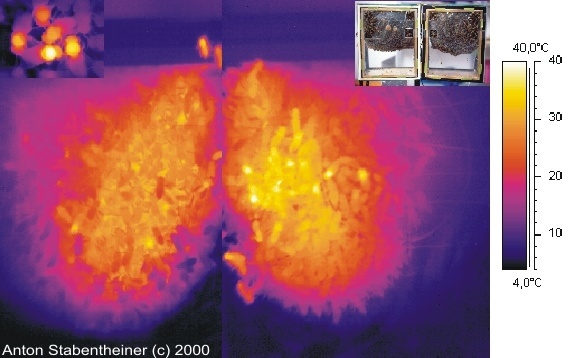
- Stabentheiner A, Vollmann J, Kovac H & Crailsheim K 2003. Oxygen consumption and body temperature of active and resting honeybees. Journal of Insect Physiology 49, 881-889.
- Stabentheiner A, Kovac H & Schmaranzer S 2002. Honeybee nestmate recognition: the thermal behaviour of guards and their examinees. Journal of Experimental Biology 205, 2637-2642.
OK Mädels, cool bleiben! Cartoon von Axel Innis in 'This issue', J. Exp. Biol. 205 (2002): (Axel Innis & J. Exp. Biol. © 2002)
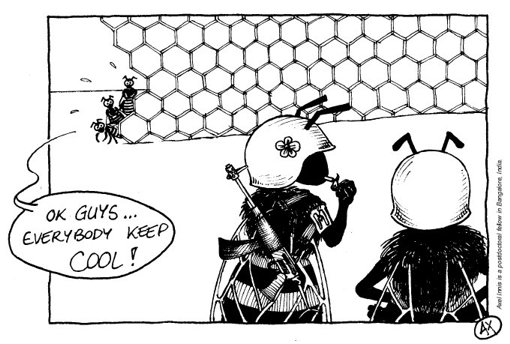
- Stabentheiner A 2001. Thermoregulation of dancing bees: thoracic temperature of pollen and nectar foragers in relation to profitability of foraging and colony need. Journal of Insect Physiology 47, 385-392.
- Kovac H & Stabentheiner A 1999. Effect of food quality on the body temperature of wasps (Paravespula vulgaris). Journal of Insect Physiology 45, 183-190.
- Stabentheiner A & Crailsheim K 1999. The effect of activity level and ambient temperature on thermoregulation in isolated honeybees (Hymenoptera: Apidae). Entomologia Generalis 24, 13-21.
- Crailsheim K, Stabentheiner A, Hrassnigg N & Leonhard B 1999. Oxygen consumption at different activity levels and ambient temperatures in isolated honeybees (Hymenoptera: Apidae). Entomologia Generalis 24, 1-12.
- Germ M, Stabentheiner A & Kastberger G 1997. Seasonal and daily variation of honeybee dancing temperature under constant feeding conditions. Apidologie 28, 385-398.
- Stabentheiner A 1996. Effect of foraging distance on the thermal behavior of honeybees during dancing, walking and trophallaxis. Ethology 102: 360-370.
- Crailsheim K, Hrassnigg, N & Stabentheiner A 1996. Diurnal behavioral differences in forager and nurse honey bees (Apis mellifera carnica Pollm). Apidologie 27: 235-244.
- Stabentheiner A, Kovac H & Hagmüller K 1995. Thermal behavior of round and wagtail dancing honeybees. Journal of Comparative Physiology B 165: 433-444.
- Bermadinger-Stabentheiner E & Stabentheiner A 1995. Dynamics of thermogenesis and structure of epidermal tissues in inflorescences of Arum maculatum L. New Phytologist 131: 41-50.
- Schmaranzer S & Stabentheiner A 1991. Berührungslose Körpertemperaturmessung bei Insekten. Biologie in unserer Zeit 21: 260-262.
- Stabentheiner A 1991. Thermographic Monitoring of the Thermal Behaviour of Dancing Bees. In: The Behaviour and Physiology of Bees (LJ Goodman & RC Fisher, eds). CAB International, Wallingford UK, pp. 89-101 and Frontispiece. ISBN 0-85198-721-4
- Stabentheiner A & Hagmüller K 1991. Sweet Food Means 'Hot Dancing' in Honey Bees. Naturwissenschaften 78: 471-473.
Titelseite Naturwissenschaften 10/1991: Infrarot-Thermogramm einer tanzenden Honigbiene (gelb) mit ihren Nachtänzerinnen (blau-rot) (Anton Stabentheiner © 1991)

- Hagmüller K, Meggeneder U & Stabentheiner A 1990. Kurzzeiteffekt von Saccharose auf den O2-Verbrauch junger Mäuse und die Thermogenese ihres Braunen Fettgewebes (BAT). Zoologische Jahrbücher Physiologie 94: 291-301.
- Kastberger G & Stabentheiner A 1989. Präsoziale Gruppenbildungen bei der Höhlenschrecke Troglophilus cavicola. Mitt Naturwiss Verein Steiermark 119: 129-135.
- Schmaranzer S & Stabentheiner A 1988. Variability of the Thermal Behavior of Honeybees on a Feeding Place. Journal of Comparative Physiol B 158: 135-141.
- Stabentheiner A & Schmaranzer S 1988. Flight-related Thermobiological Investigations of Honeybees (Apis mellifera carnica). In: BIONA-report 6 (Nachtigall W, ed), Akademie der Wissenschaften und Literatur zu Mainz: Gustav Fischer Verlag, Stuttgart, New York, pp 89-102. ISBN 3-437-20434-3, ISBN 0-89574-289-6 (USA), ISSN 0930-0635
- Stabentheiner A, Schmaranzer S, Heran H & Ressi R 1988. Verändertes Thermopräferendum von Jungbienen durch Intoxikation mit Roxion-S (Dimethoat). Mitteilungen Dtsch Ges allg angew Ent 6: 514-520.
- Schmaranzer S, Stabentheiner A & Heran H 1987. Effect of Roxion-S (Dimethoate) on the Body Temperature of the Honey-Bee. In: Chemistry and Biology of Social Insects (Eder J & Rembold H, eds), Verlag J. Peperny, München, pp 241. ISBN 3-925995-01-3.
- Stabentheiner A & Schmaranzer S 1987. Thermographic Determination of Body Temperatures in Honey Bees and Hornets: Calibration and Applications. Thermology 2 (4): 563-572. (1.8 MByte)
Vierfach preisgekrönter wissenschaftlicher Film:
Film "THERMOGRAFIE BEI BIENEN" -
Sigurd Schmaranzer, Anton Stabentheiner, Herbert Heran 1987 (272 MB, bessere Qualität-aber Download kann dauern!):
Produktion: Österreichisches Bundesinstitut für den Wissenschaftlichen Film, Wien (Direktor: Siegfried Hermann).
Kamera: Visuell - Herbert Kerschner; Infrarot - Sigurd Schmaranzer & Anton Stabentheiner; Schnitt: Susanne Thomas; Produzenten/Gestaltung: Herbert Kerschner & Margit-Andrea Hawlik; Assistenz: Hannes Vogelsam; Drehbuch: Anton Stabentheiner & Sigurd Schmaranzer; Organisation, Bienendressuren, wissenschaftliche Gestaltung & Kommentar: Sigurd Schmaranzer, Anton Stabentheiner & Herbert Heran.
Streaming-Version »» an der © Österreichischen Mediathek (Austrian Media Library) (102 MB)
Zitate:
- Schmaranzer S, Stabentheiner A & Heran H 1987. Thermografie bei Bienen. Film C 2046 des ÖWF Wien: Bundesinstitut für den Wissenschaftlichen Film 1987. 16-mm-Film, Magnetton, Farbe, Deutscher Kommentar.
- Begleitpublikation:
- Schmaranzer S, Stabentheiner A & Heran H 1988. 'Thermografie bei Bienen'. Wiss Film 38/39: 64-68.
Preise:
- PEKING (Volksrepublik China) 1987 - Auszeichnung mit einem DIPLOM!: 1. Internationaler Filmwissenschaftlicher Kongreß in Peking
- RONDA (Spanien) 1987 - Auszeichnung mit einem EHRENPREIS!: 10. Internationale Woche des Wissenschaftlichen Films
- PARDUBICE (CSFR) 1988 - Auszeichnung mit einem DIPLOM!: XXXIX. ISFA-Kongreß
- BRÜSSEL (Belgien) 1988 - Auszeichnung mit dem 'PRIX DE LA COMMUNICATION SCIENTIFIQUE' der Europäischen Union: 10. Festival International du Film Scientifique et Technique
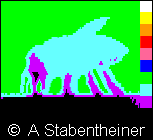
Animation: Infrarot-Thermografie einer Honigbiene - Aufheizen des Thorax in der Flugvorbereitung (reale Dauer: ca. 1 min)
